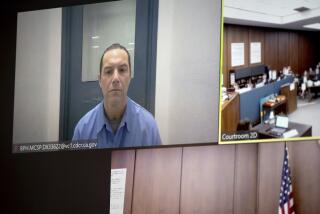DNA evidence means freedom after 2 decades
WASHINGTON — Paul House, a Tennessee death row inmate, was just one vote away from possible execution when a divided Supreme Court said three years ago that new DNA evidence called for reopening his case.
The Tennessee Supreme Court already had rejected his appeals, as had the U.S. Court of Appeals in Cincinnati.
On Tuesday, a local prosecutor who had vowed after the landmark Supreme Court ruling to retry House dropped all charges, saying a new round of DNA tests on four pieces of evidence from the crime scene -- including hair and material from under the victim’s fingernails -- all pointed to an unknown suspect.
Lawyers for the Innocence Project in New York said the outcome in the House case should give judges great pause. “The Supreme Court was right to make sure all the evidence was fully considered in this case,” said Peter Neufeld, a co-director of the organization.
House, a paroled rapist from Utah, had moved to a rural area of east Tennessee shortly before Carolyn Muncey was found dead in the summer of 1985. He had been seen walking along a road near where her body was discovered. And he had no good explanation for where he was on the evening of her killing.
Long after his conviction, however, DNA evidence proved that a semen stain on the victim’s clothes had come from her husband, not House.
But the Tennessee courts and the federal appeals court said that evidence did not prove he was not guilty. The judges said there was still “strong circumstantial” evidence against House. One dissenter on the federal court, however, called the case “an authentic whodunit where the wrong man may be executed.”
For two decades, the Supreme Court had put up procedural barriers against reconsidering old cases. But the justices took up House’s appeal to consider, for the first time, whether new DNA evidence could require reopening an old case.
In a 5-3 decision in House vs. Bell, Justice Anthony M. Kennedy said that “reliable new evidence” calls for taking a new look at an old case if it casts real doubt on the defendant’s guilt. If the court had split 4-4, the conviction would have been upheld.
The three dissenters, led by Chief Justice John G. Roberts Jr., said House did not “present such compelling evidence of innocence” to require reopening his case.
Until this week, veteran prosecutor Paul Phillips had said he would retry House if necessary and win a conviction. But Tuesday, he announced he was dropping the charges.
The new evidence “raises a doubt about his culpability. We couldn’t go forward,” Phillips said in an interview. He said he remained convinced that House knew something about the slaying, even if he was not the killer.
“Technology exists today that we didn’t have 24 years ago. And it clearly shows other people were involved in this crime,” he said.
Stephen Kissinger, a federal public defender who has represented House since 1997, said he was frustrated that the prosecutor refused to admit an error had been made.
“He is conclusively innocent,” he said of House. “The DNA evidence has totally excluded him. If the state of Tennessee had had its way in this case, he would have been dead 10 years ago.”
The Supreme Court is expected to hand down a decision soon in an Alaska case on whether prison inmates have a constitutional right to submit old evidence for DNA testing.
--
More to Read
Sign up for Essential California
The most important California stories and recommendations in your inbox every morning.
You may occasionally receive promotional content from the Los Angeles Times.











